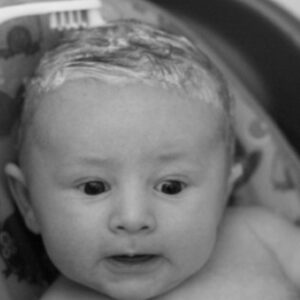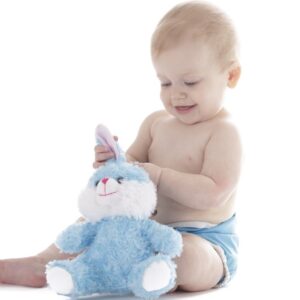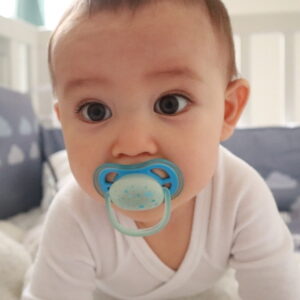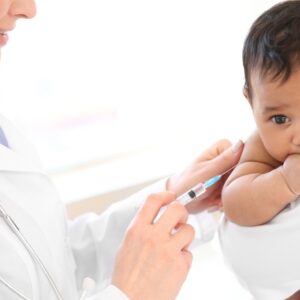Babies and young children should not be sunburnt. We all know that, right? But how can you can make sure your kids are safe in the sun, and what to do if your child does get sunburned?
This article provides detailed tips and information on sun safety for babies and toddlers in particular, but most of the advice can be used for older kids and even adults as well.
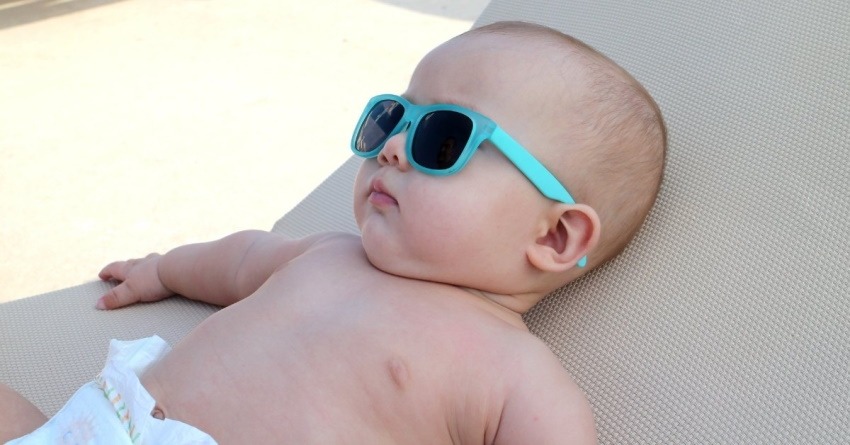
Warm weather months are a great time to have some “fun in the sun.” While spending a day at the beach or having a picnic in the park, there are a few things to keep in mind in order to enjoy outdoor time safely.
As global temperatures become hotter each year, good planning can prevent kids from becoming overheated. It is also important to protect the more sensitive skin of infants and children from the sun. Sunburns and heatstroke can occur when the precautions are not taken.
The Sun Story
The sun’s heat and energy are present in the form of ultraviolet radiation. This energy is in the form of UVA, UVB, and UVC sun rays. The earth’s ozone layer protects us from all UVC rays, some UVB ones, but no UVA rays. As the ozone layer becomes thinner due to the effects of pollution, more harmful sun rays pass through it, and can adversely effect the skin. UVB rays damage the outer skin surface. UVA rays penetrate deeper, and can damage the inner skin ayers.
Other factors influence the amount of skin sun exposure. Daytime sun is most intense between the hours of 10 am and 4pm. Sand, water, and snow all reflect the sun’s rays, creating multi-directional skin exposure. UVA and UVB rays are also stronger near the equator and at higher elevations.
The video below explain more about the sun’s harmful effects and why sunscreen is needed.
Temperature vs Heat Index
In local weather reports, the heat index is often reported along with daily temperature ranges. The heat index takes into account humidity along with the outdoor temperature. The human body cools itself with sweat which evaporates to dissipate heat. When air is too humid, this evaporation cannot occur, and the body remains hot. This increases the risk of and infant or child becoming overheated if measures are not taken to keep them cool.
Vitamin D and Skin Sun Exposure
A limited amount of sun exposure is beneficial. The sun’s rays trigger a chemical reaction within the skin to form vitamin D which is further processed by the liver, kidneys, and intestines. 30 minutes of sun exposure is recommended. How much vitamin D is produced varies with the amount of melanin, or pigment, in skin. In a half hour, 50,000 units of vitamin D form in fair skin individuals compared to 10,000 units in those with darker skin. It may also be obtained from foods such as fortified cow’s or plant-based milks, cereals, and fish.
Vitamin D is unique in that it functions like a hormone within the body. It helps calcium accumulate into bones to provide strength, important for growth as well as preventing fractures. It is also a component of the blood cells that fight infections. In addition, there is ongoing research into its ability to prevent certain cancers, and promote brain function.
Why Too Much Sun Exposure Is Not Good
Skin Effects
When too much time is spent in the sun, the likelihood of developing a sunburn increases. Melanin provides some amount of protection, but does not fully block the sun’s rays. Infant skin is even more at risk because it is thinner than that of adults and older children. UVA rays cause the immediate sunburn symptoms of redness and pain, while UVB rays are responsible for the persistent burning sensation that develops later. Both types of sun rays are associated premature skin aging, and an increased risk of skin cancer.
The Eyes
The inner eye is protected by the cornea and lens which are directly exposed to sunlight. However, in infants and children, sun rays are not fully filtered away. As a result, corneas can become sunburned. Overtime, this direct sun exposure can lead to the formation of cataracts, eyelid cancers, and other problems.
Heatstroke
On high heat index days, infants and young children can easily become overheated while spending time outdoors. Heatstroke is defined as a sustained body temperature above 104 degrees F along with signs of lethargy or unresponsiveness. Infants and toddlers are particularly at risk when outdoor humidity levels rise above 75 percent because they become unable to sufficiently cool their bodies by sweating. Due to their larger skin body surface area, infants also absorb more heat from the environment.
Signs of heatstroke include:
- Excessive drowsiness
- Fever
- Breathing that is too rapid or slow
- Loss of Consciousness
- Hot, flushed skin without sweat
If heatstroke is not recognized or there is a delay in seeking care, it can result in organ failure and death. Read more about heat stroke here.
Sun Safety Strategies
The best way to prevent sunburns and becoming too hot is to avoid spending time in direct sunlight between the hours of 10am and 4pm. When this is not possible, here are some additional prevention measures.
Infants
The thinner skin of infants is at a greater risk of sunburns, and they become overheated much faster. Because of this, babies should not be placed in direct sunlight, especially under the age of six months. They should be kept in the shade, and wear protective clothing. Strollers with canopies can be helpful. Infant-sized hats help to protect the face and eyes, and sunscreen should be used. Previously, sun creams and lotions were not recommended for infants under six months old. The AAP has since revised its policy. When time in the sun is unavoidable, a small amount of sunscreen may be applied to exposed skin areas.
To keep infants hydrated, parents should offer the usual frequency of breast or formula feedings, typically every two to three hours. For infants over age six months, cold pureed foods and sips of water can be offered as well. A well hydrated baby should have six to eight wet diapers per day.
Children
Sunscreen should be applied 15 to 30 minutes prior to going to the pool or beach, but also for other outdoor activities. Athletic team uniforms may not provide enough sun protection during games. Exposed skin can become sunburned even while skiing or snowboarding due to rays that reflect off the snow. Sand and water also emit reflected sun. For the eyes, most children over the age of three should be able to wear sunglasses, but infant versions are now available. Parents should check with the manufacturer to be sure the sunglasses protect against both UVA and UVB rays.
When planning a summer day away from home, it is important to pack items to combat the heat. Beach umbrellas or tents are a great way to create shaded areas. In addition to cold water and/or electrolyte enhanced beverages, cold fruits, raw veggies, and yogurts can help keep children cool. Kids may need reminders to take “cool down” breaks from play to re-hydrate.
A Note About Hot Cars
In 2021, 23 children died while inside of a hot car in the US only. This static includes those who were with either left in a car, or who found a way inside of a parked car. A closed vehicle can become hotter than the outdoor temperature. Open car windows are ineffective for keeping an infant or child cool.
To avoid such tragedies, parents should make a habit of checking the back seat before locking their car. Placing bags or other essential items on the rear seat can serve as reminders to look for an infant or child. Parked cars should always be kept locked and with windows closed to prevent a child from entering. Many auto manufacturers have begun installing devices that alert parents to the presence of a child. Some infant car seats have similar reminders.
Types of Sun Protection
Sunscreens
SPF, or sun protection factor, refers to the amount of ultraviolet radiation that causes a sunburn on unprotected skin. The higher the SPF number, the more protection is provided. This number, however, does not reflect the length of time that the skin is protected. SPF may apply to a lotion, cream, or spray.
Sunscreens range from SPF 4 to 100, but an SPF of at least 15 is recommended by most health authorities. There is disagreement regarding the efficacy of products with an SPF higher than 50, but some studies do indicate they may offer more protection. Sunscreens that are labeled “broad spectrum” protect against both UVA and UVB rays. They should be applied to all skin areas at least 15 to 30 minutes prior to sun exposure, avoiding the eyes and mouth. Most of these products “wash off” in water, so they should be re-applied every 40 to 80 minutes when swimming.
Sunscreen Sprays
Because parents feel they are easier to apply, sunscreen sprays have gained popularity. However, care must be taken to make sure all skin surfaces are well sprayed. Sunburns can occur on missed areas, especially when used on a windy day. In addition, the aerosols used in these sprays are flammable. They should not be used or worn near a fire pit, barbecue grill, or any open flame.
Concerns About Conventional Sunscreens
Over the years, concern about the environmental effects of some sunscreen ingredients has increased. Oxybenzone, octocrylene, octinoxate, and ethylhexyl salicylate have been detected in water sources around the world. These chemicals are difficult to remove with conventional water treatment techniques. Oxybenzone, in particular, has been associated with the bleaching of coral reefs. Many localities have since banned its use to protect marine life.
Research also shows that significant amounts of oxybenzone and other commonly used ingredients are absorbed through the skin. Some may have toxic and hormonal effects. Infants and children with sensitive skin may experience allergic reactions to certain sunscreen ingredients.
Mineral Based Sunscreens
Mineral-based sunscreens are alternative to conventional ones. They involve combining a variety of mineral compounds to zinc oxide or titanium dioxide. The minerals then provide protection by repelling UVA and UVB rays. These products are ideal for those with sensitive skin, and they are safe for the environment.
Sun Protective Clothing
Sun protective hats and clothing are labeled with a UPF or ultraviolet protection factor. They are manufactured in a way that the sun cannot easily penetrate the fabric, providing a UPF of 50 or greater. Although durability wanes with laundering over time, in most cases, the protection lasts two to three years. While wearing these garments, sunscreen should still be applied to exposed areas of skin. Clothing manufactures make UPF onesies and hats with wide brims for infants. UPF shirts and swimwear are available for toddlers and older children.
Sunglasses
There are a variety of sunglasses for infants and toddlers on the market. Many are designed a strap to help them stay in place. Sunglasses that provide the best protection are labelled “100% UV protection”, meaning that they block the majority of harmful UVA and UVB sun rays.
How To Manage A Sunburn
Despite the best prevention efforts, sunburns may happen. The important first step is to cool down the skin as quickly as possible. Moving the child to a shaded area, and applying cool water can reduce severity of the sunburn. Aloe vera gel further cools the skin, and soothes the irritation. Over-the-counter pain relievers such as ibuprofen and acetaminophen can reduce the intensity of the pain.
Oral hydration is important to replace skin fluid losses, and correct dehydration following prolonged sun exposure. Burns that are associated with blisters or that cover a large area of the body may require medical attention. In these situations, topical antibiotic ointments may be prescribed to prevent infection in addition to pain management.
What To Do If When A Child Becomes Overheated
Because heatstroke is life threatening, parents should first call emergency services. The infant or child should be moved to an air conditioned location, and cool, moist towels should be applied to the body. If the child is not vomiting and alert enough to drink, fluids should be offered.
FAQs about Sun Safety for Babies and Toddlers
What happens if my baby is exposed to the sun?
This depends on a variety of factors such as whether or not the sun exposure was direct, length of time in the sun, and what precautions were taken. Because infant skin is more fragile, even second degree sunburns with blisters are possible. The risk of future skin cancers is high because the melanin has not fully developed in infant skin, allowing the sun’s rays to penetrate deeper.
How much sun is safe for a baby?
Thirty minutes of indirect sun exposure is safe for infants, and can promote vitamin D production. This is can be particularly helpful for breastfeeding infants who are not taking a vitamin D supplement.
What is a “baby safe” sunscreen?
Because the potential longterm health effects of oxybenzone are still being studied, it is probably best to avoid sunscreens that contain this ingredient. Mineral-based options that include zinc oxide (a common diaper paste ingredient) are good alternatives. Most of these sunscreens, however, only provide up to an SPF of 30.
To limit the use of sunscreens, it is best to cover most of an infant’s body with sun protective clothing. It can then be applied to the remaining exposed skin.
Should an infant wear sunscreen under six months old?
In situations where sun exposure is unavoidable such as at the beach, theme parks, or outdoor events, yes, sunscreen should be worn. It is better to protect the baby’s skin than for him or her to develop a sunburn. It is preferable, however, for infants to wear clothing and hats with a UPF rating, and reserve the use of sunscreen for exposed skin areas.
How do you treat a baby’s sunburn?
The baby should be brought indoors to stop the progression of the sunburn. A lukewarm bath can help cool the skin, and provide some relief. Acetaminophen can reduce any discomfort caused by the sunburn. If a large area of the infant’s body has sustained a sunburn or blisters form, parents should consult a doctor.
Can babies become ill from a sunburn?
Yes, it is possible for babies to develop a severe sunburn. In addition to skin redness and discomfort, infants may look as if they have an infection. Fever and vomiting are possible.
Why is it an emergency when infants gets a sunburn?
In addition discomfort and irritability, sunburns can be associated with dehydration. Fluid is lost from sweating. Any blisters that form are also filled with fluid which means less circulating throughout the body. Because of this, one of the first steps of emergency management is the administration of intravenous fluids.
Is sunscreen necessary for infants and children who have darker skin tones?
Yes. Regardless of the amount of melanin, infants and children should wear sunscreen. Infant skin is thinner than that of older children, and, therefore, gets more penetration of damaging sun rays. Melanin and other components of the skin continue to mature throughout the first two years of life, so there isn’t enough UV protection. Although darker pigmented skin is less likely to sustain a sunburn, wearing sunscreen reduces the risk of future skin cancers.
Do toddlers need sunscreen in the shade?
Yes. Shaded areas reduce direct sunlight exposure, but sun rays can reflect off light-colored pavement, sand, water, and snow.
How do I get my toddler to wear sunscreen?
Making sunscreen application part of your “going out” routine can help toddlers become accustomed to this task. Sunscreen can be applied prior to getting dressed which allows time for maximum efficacy. It should be applied 15 to 30 minutes prior to sun exposure. When it is time to reapply it, using this as an opportunity for some “down time” or a “hydration break” may also increase compliance.
How much sunlight is good for newborn jaundice?
Ultraviolet light is the standard treatment for infants with jaundice during the neonatal period. Special lamps are used in the newborn nursery, and occasionally at home. For cases of mild jaundice, sunlight may be recommended as an alternative. The exact amount of time for using this method has not been established, however, and may be different for each baby. If considering sunlight to reduce jaundice, parents should have a discussion with a doctor. Research studies show that, although effective, placing a baby in direct sunlight increases risk of a sunburn or overheating. A filtering device may be recommended to prevent such adverse effects.
Read Next about Babies and Toddlers in Hot Weather
- 6 Tips for Toddler or Baby in Hot Weather to Keep Them Safe
- How to Prevent and Treat Heat Stroke In Babies & Toddlers
- 10 Tips for a Wonderful (Sunny) Vacation with Your Baby!
- Child Water Safety and Drowning Prevention: Tips, Facts, FAQ
References
- Vitamin D
- Sunlight for the prevention and treatment of hyperbilirubinemia in newborns
- Radiation: Ultraviolet (UV) radiation (who.int)
- Your Child’s Eyes Need Protection From the Sun, Too | University Hospitals (uhhospitals.org)
How do you practice sun safety for your baby or toddler? Share any tips or questions by leaving a comment below. :-)

Paula Dennholt founded Easy Baby Life in 2006 and has been a passionate parenting and pregnancy writer since then. Her parenting approach and writing are based on studies in cognitive-behavioral models and therapy for children and her experience as a mother and stepmother. Life as a parent has convinced her of how crucial it is to put relationships before rules. She strongly believes in positive parenting and a science-based approach.
Paula cooperates with a team of pediatricians who assist in reviewing and writing articles.


